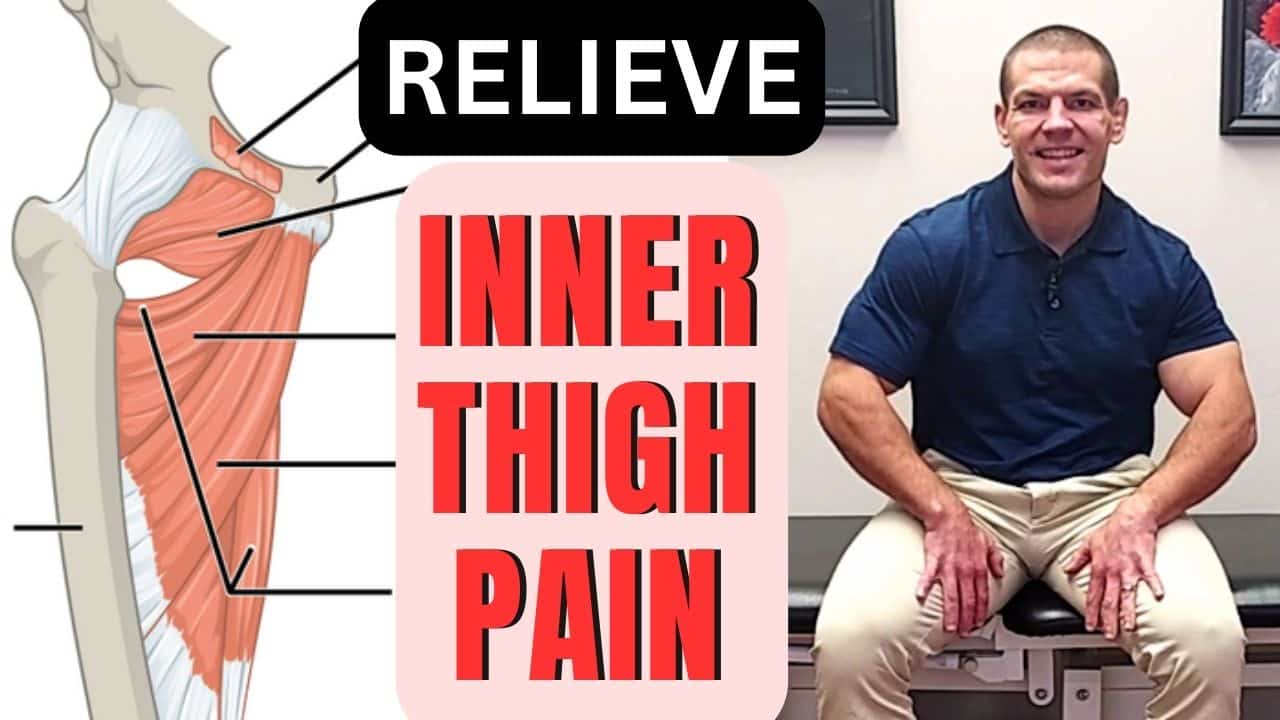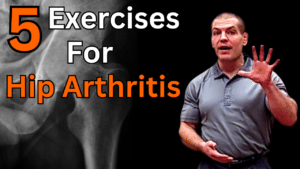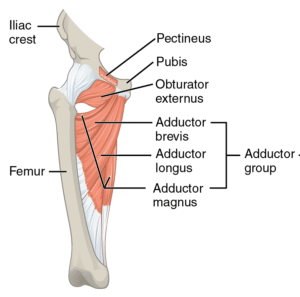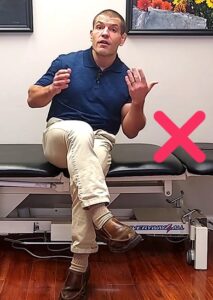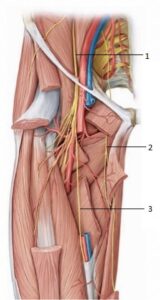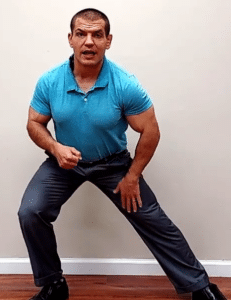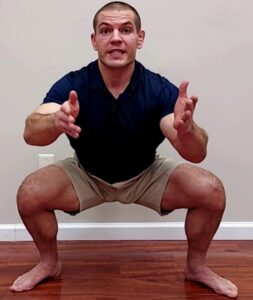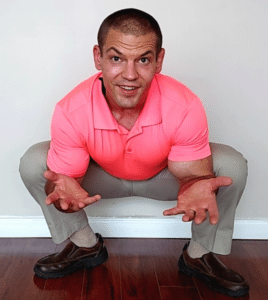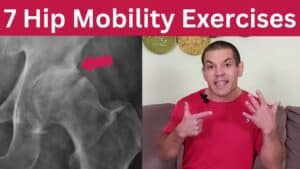Do You Get Inner Thigh Pain?
If you get inner thigh pain, you may wonder what's causing it and what you can do to relieve it.
In the video below, I'll explain the framework that I use when evaluating a patient with inner thigh pain, as well as give you some tips for both immediate and lasting relief.
Table of Contents
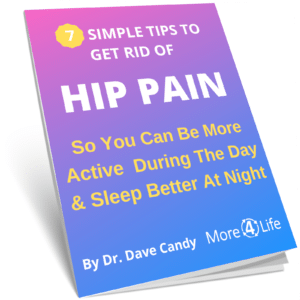
4 Causes Of Inner Thigh Pain
First of all, what causes inner thigh pain?
Whenever I evaluate a patient with inner thigh pain, or really any type of pain for that matter, I'm looking at basically four categories of different things:
- Non-musculoskeletal causes
- Joint causes
- Muscular causes
- Nerve causes
Inner Thigh Pain From Non-Musculoskeletal Causes
Number one, is it even a musculoskeletal problem? At More 4 Life, we're physical therapists. We're skilled at treating musculoskeletal causes of inner thigh pain.
However, we need to at least be able to recognize non-musculoskeletal causes of inner thigh pain so that we can refer people to other resources to get help for those conditions.
Non-musculoskeletal causes of inner thigh pain include (but not limited to):
- kidney stones
- urinary tract infections
- reproductive system causes
- hernias
Those conditions can all cause inner thigh pain.
These are not the most common causes, but it is important to be aware of them.
Some symptoms of an internal medicine cause may include:
- pain when urinating
- menstrual period irregularities
- abdominal cramps
However, many types of inner thigh pain are caused by musculoskeletal causes.
Joint Causes of Inner Thigh Pain
Hip joint problems can cause inner thigh pain. Examples of these problems include:
Hip arthritis is the most common problem, especially among middle-age and older adults.
With a hip joint dysfunction, pain is typically felt during weight-bearing on the affected hip joint, or at end ranges of motion.
End-range hip flexion, adduction, and internal rotation places the hip joint in the most compressed, closed-pack position.
Muscular Causes of Inner Thigh Pain
In addition to hip joint problems, muscles can also cause inner thigh pain.
The inner thighs muscles are collectively known as hip adductors.
They bring the hip into the motion of adduction or towards the midline of the body.
If you have a hip adductor muscle problem, you'll probably feel pain upon muscle exertion. For example, you might feel pain when pushing inwards against resistance.
Additionally, you may get pain when you stretch your leg away from midline (into abduction).
Furthermore, hip adductor muscles can hurt because they're either overstretched (strained) or because they're too stiff and short.
Treatment approaches for an overstretched/strained muscle is the opposite for treating a short muscle.
If you have an overstretched or strained, you don't want to stretch it farther.
However, it is the common thing that many people try doing when they have a strained muscle.
Conversely, if you have a stiff muscle, stretching is probably the appropriate treatment.
Functional treatments to a short or stiff hip adductor muscle address proper positioning or mechanics when performing daily tasks.
For example, you want to avoid crossing your legs when sitting for long periods of time.
Additionally, placing a pillow between your thighs when you're side-sleeping helps maintain the thighs in a parallel position.
Without the pillow, the hip adductors are placed in a shortened position.
As a result, sleeping on your side without the pillow between the legs shortens the hip adductors for the duration of your sleep.
Nerve Causes Of Inner Thigh Pain
Nerves can also be a cause of inner thigh pain.
The obturator nerve runs down the inner thigh. (#2 in the picture below)
As a result, stiff adductor muscles can put pressure on that obturator nerve and cause symptoms.
Additionally, the obturator nerve is made from the L2, L3, and L4 nerve roots in your lower back.
If you have a pinched nerve at one of those levels, that can cause inner thigh pain, numbness, or tingling.
Therefore, there are many different sources that can cause pain at your inner thigh.
It is important to get a proper diagnosis to get to the proper treatment approach.
Treatments For Inner Thigh Pain
Treatments for the muscular causes are the easiest to implement.
As previously mentioned, functional treatment for inner thigh pain includes side-sleeping with a pillow between the thighs/knees and avoiding sitting cross-legged.
Additionally, it's helpful to stretch out the inner thigh muscles.
Stretches for Inner Thigh Muscles
Seated Adductor Stretch (Butterfly)
A sitting hip adductor stretch involves sitting with your feet together and pushing your elbows down into your knees.
Pull your feet in as far as you feel comfortable going. Then use your elbows to push your knees down towards the bed.
Additionally, you can use a few neurological tricks to get your inner thigh muscles to relax.
Push down on your knees using your elbows. Then use your hip adductor muscles to push your knees back against your elbows.
Hold this contraction for about five to 10 seconds. After you relax, the muscle goes through a period of relaxation that will allow you to push your thighs outwards further for an increased stretch.
This is concept is called autogenic inhibition, because the muscle inhibits itself.
Another trick involves using your gluteal/buttock muscles to actively pull your knees down towards the bed.
Hold the muscle contraction for 10 seconds.
Then relax and use your elbows to further stretch the adductor muscles.
When you contract your glutes, the hip adductors relax. This technique is called reciprocal inhibition because the glutes inhibit their opposing muscle group.
Alternate between using these autogenic and reciprocal inhibition techniques while stretching to get a good stretch of your inner thigh muscles.
Standing Hip Adductor Stretch
Another way to stretch out your inner thigh muscles is standing in a side lunge position.
You should feel a slight stretching on the inner thigh.
For an active stretch like the seated version, push off the stretched leg and activate your gluteal muscles for 10 seconds.
Then, relaxing the contraction and further stretching the hip adductors.
This stretch is really important because stiff inner thigh muscles corresponds with weak gluteal muscles.
To further increase your gluteal muscle strength while stretching the hip inner thigh muscles, try the next stretch.
Horse Stance
Additionally, the horse stance is an advanced exercise that actively stretches the hip adductors and strengthens your glutes.
With this exercise, start out with your feet slightly wider than shoulder-width apart and perform of a slight squat while driving your knees out.
Ideally, squat down until your thighs are parallel with ground.
However far down you can get, use your elbows to push your knees out similar to the previous sitting stretch.
Then, use your glutes to actively push your legs out.
If this stretch is to hard for you, try the modified horse stance.
For the modified version of the horse stance, you just want to sit on a chair and straddle the back of the chair.
Then put your feet on the ground.
Push your heels down into the ground just as if you were squatting and then drive your knees out a little bit farther.
By doing this, you're stretching your inner thigh muscles while you're strengthening your glutes.
Learn more about the horse stance here.
Now, what if you have more of a joint problem?
Treatment For Inner Thigh Pain From Joint Problems
What if you have inner thigh pain from hip arthritis?
Well, in that case, the pain is actually coming from the ball of the hip pressing up into the socket.
When you're standing, if you have weak glutes, that's going to cause your pelvis to drop down a little bit and put more force on that hip joint.
Therefore, it's important that you strengthen your glute muscles.
The other stretching exercises that I just covered all incorporated the glutes.
So those are good not just for muscle problems, but also for hip arthritis pain that's being referred down into the inner thigh.
However, if you have hip arthritis, it's also important be able to balance yourself appropriately on one leg.
To do this, stand on one leg while activating your glutes and keeping your belt level with the floor.
Additionally, you want to make sure you maintain as much mobility as possible in the joint.
Here are a few hip joint mobilization exercises that you can do at home.
However, although these exercises can be helpful, they can also be a little complex to learn how to do correctly.
Additionally, they're used to mimic hands-on joint mobilization techniques that we use here in the office, but they're not as effective as having a person manual mobilize your hip.
If you live in the St. Louis area, and need more help for inner thigh pain, we'd be happy to help you here at More 4 Life.
Just tap the button below to request an appointment with one of our specialist physical therapists.

